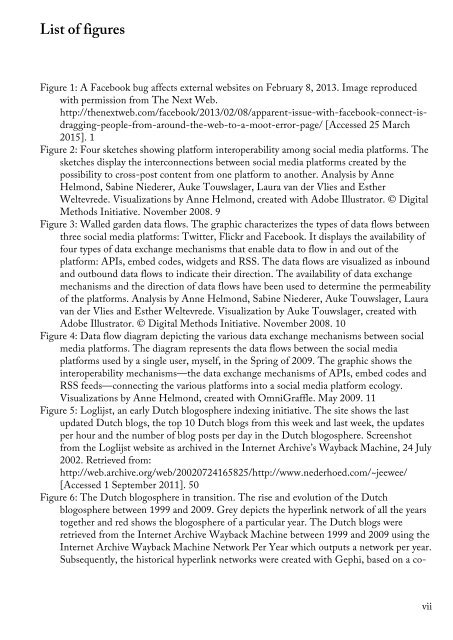as Platform
Helmond_WebAsPlatform
Helmond_WebAsPlatform
Create successful ePaper yourself
Turn your PDF publications into a flip-book with our unique Google optimized e-Paper software.
List of figures<br />
Figure 1: A Facebook bug affects external websites on February 8, 2013. Image reproduced<br />
with permission from The Next Web.<br />
http://thenextweb.com/facebook/2013/02/08/apparent-issue-with-facebook-connect-isdragging-people-from-around-the-web-to-a-moot-error-page/<br />
[Accessed 25 March<br />
2015]. 1<br />
Figure 2: Four sketches showing platform interoperability among social media platforms. The<br />
sketches display the interconnections between social media platforms created by the<br />
possibility to cross-post content from one platform to another. Analysis by Anne<br />
Helmond, Sabine Niederer, Auke Touwslager, Laura van der Vlies and Esther<br />
Weltevrede. Visualizations by Anne Helmond, created with Adobe Illustrator. © Digital<br />
Methods Initiative. November 2008. 9<br />
Figure 3: Walled garden data flows. The graphic characterizes the types of data flows between<br />
three social media platforms: Twitter, Flickr and Facebook. It displays the availability of<br />
four types of data exchange mechanisms that enable data to flow in and out of the<br />
platform: APIs, embed codes, widgets and RSS. The data flows are visualized <strong>as</strong> inbound<br />
and outbound data flows to indicate their direction. The availability of data exchange<br />
mechanisms and the direction of data flows have been used to determine the permeability<br />
of the platforms. Analysis by Anne Helmond, Sabine Niederer, Auke Touwslager, Laura<br />
van der Vlies and Esther Weltevrede. Visualization by Auke Touwslager, created with<br />
Adobe Illustrator. © Digital Methods Initiative. November 2008. 10<br />
Figure 4: Data flow diagram depicting the various data exchange mechanisms between social<br />
media platforms. The diagram represents the data flows between the social media<br />
platforms used by a single user, myself, in the Spring of 2009. The graphic shows the<br />
interoperability mechanisms—the data exchange mechanisms of APIs, embed codes and<br />
RSS feeds—connecting the various platforms into a social media platform ecology.<br />
Visualizations by Anne Helmond, created with OmniGraffle. May 2009. 11<br />
Figure 5: Loglijst, an early Dutch blogosphere indexing initiative. The site shows the l<strong>as</strong>t<br />
updated Dutch blogs, the top 10 Dutch blogs from this week and l<strong>as</strong>t week, the updates<br />
per hour and the number of blog posts per day in the Dutch blogosphere. Screenshot<br />
from the Loglijst website <strong>as</strong> archived in the Internet Archive’s Wayback Machine, 24 July<br />
2002. Retrieved from:<br />
http://web.archive.org/web/20020724165825/http://www.nederhoed.com/~jeewee/<br />
[Accessed 1 September 2011]. 50<br />
Figure 6: The Dutch blogosphere in transition. The rise and evolution of the Dutch<br />
blogosphere between 1999 and 2009. Grey depicts the hyperlink network of all the years<br />
together and red shows the blogosphere of a particular year. The Dutch blogs were<br />
retrieved from the Internet Archive Wayback Machine between 1999 and 2009 using the<br />
Internet Archive Wayback Machine Network Per Year which outputs a network per year.<br />
Subsequently, the historical hyperlink networks were created with Gephi, b<strong>as</strong>ed on a co-<br />
vii


